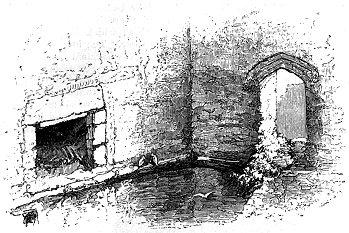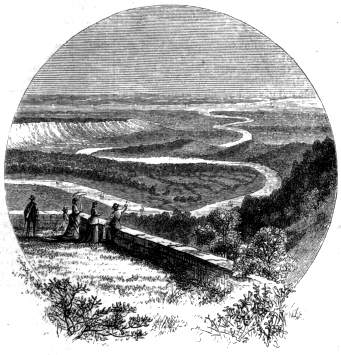|
|
On The Welsh Border.,
Page 6 of 14  Fire-Place In The Keep.
Puritan’s chamber. Southey, standing here in sentimental mood, wrote of Marten thus:
“Often have these walls Echoed his footsteps as with even tread He paced around his prison. Not to him Did Nature’s fair varieties exist; He never saw the sun’s delightful beams, Save when through yon high bars he poured a sad And broken splendor.” Better authority than the poet, however, tells us that the old regicide was not shut up in a cell, nor left lonely, but had his wife and daughters with him, and not only the range of the whole castle, but freedom to visit in the neighborhood. No doubt Marten led a happier and pleasanter life during his twenty years’ residence at Chepstow than he did in his earlier and freer days. The view from the castle walls on this side shows the river Wye where it winds to the broad bosom of the Severn, through a fair hedge-rowed land. The serpentine course of this river has been supposed to be the origin of its name; but wye is a Welsh termination constantly employed in naming the rivers of Wales, as Towy, the spreading river Llngwy, the dusky river; Elwy, the sonorous river, etc. Like all the rivers which empty into this estuary, it shares for some distance from its month the restless heavings of the sea, rising and falling, with a variation of fifty or sixty feet, under the influence of the spring-tides. From the tower of Marten we walk out through a caseless doorway in the third story, or what was once the third story, on to the top of the castle wall, which has a sunken pathway below the battlements, now overgrown with ivy and with grass. Carved in the stone of The threshold we observe the letters D. B., which are the monogram of his grace Henry Charles Fitzroy Somerset, Duke of Beaufort, Knight of the Garter, Lord of Raglan, Chepstow, and Gower. This worthy knight is the owner of ruins enough to break the heart of a poor man, for ruins, however grand and picturesque, are utterly unprofitable; and not only that, they must be kept in order in these days of reverence for antiquities, or their proprietor will not receive popular approbation. The Duke of Beaufort not only owns Chepstow, but he owns Usk (already de-  The Rivers Wye And Severn, From Chepstow Castle Walls.
|
|
6
Books & articles appearing here are modified adaptations
from a private collection of vintage books & magazines. Reproduction of these pages is prohibited without written permission. © Laurel O'Donnell, 1996-2006.
|
|

